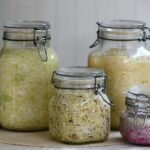Low-Sodium Sauerkraut
Looking for a way to make sauerkraut a bit less salty? Here is a recipe for low-sodium sauerkraut that is still fermented and packed with probiotics! See the section above for 4 ways to deal with too-salty sauerkraut.
- Prep Time: 15 minutes
- Total Time: 15 minutes
- Yield: 2 Quarts 1x
- Category: Vegetables
- Method: Fermentation
- Diet: Low Salt
Ingredients
Scale
- 1 head of cabbage (approx. 2 lbs.)
- Pickling salt (to taste)
- 1 package of vegetable starter or 1/2 cup of homemade starter (see notes)
- Flavors (see notes for suggestions)
Instructions
- Wash the cabbage and remove the outer leaves. Finely chop or grate the cabbage into a large bowl. Salt is optional with this particular kraut, so feel free to skip it, or add as much as you want. I recommend slowly adding salt, then tasting it until you reach the desired level of saltiness. If you’re using a packaged powdered vegetable starter, then add it at this point. Give everything a good stir.
- A large head of cabbage with make 2 quarts (2 L) of kraut. Feel free to pack in one large jar or divide it among several smaller jars. After filling the jar halfway, add either a 1/2 cup of water or 1/2 cup of homemade vegetable starter. Without the usual amount of salt, the cabbage will take longer to release its liquid. So the additional liquid is necessary to ensure a good ferment.
- Use a wooden spoon to press the cabbage down into the jar. Continue packing the cabbage into the jar, leaving at least 1 inch (2.5 cm) of room at the top.
- Since this is a low-sodium ferment, it’s important to prevent contamination. Cap the kraut with a lid that will allow CO2 to escape while preventing unwanted mold and yeast contamination. Fido jars or pickle pipes are perfect.
- Place the jar(s) somewhere dark to ferment. It will start to bubble within 24 hours and remain very active for 2 to 3 days. I recommend moving it to the fridge after 3 days when it’s at peak fermentation. If you want to let it go for longer, keep a close eye on it, and don’t let ferment for more than 7 days before moving it to the fridge. It will taste sweeter than typical sauerkraut, and be packed with lots of probiotic cultures!
Notes
- A vegetable starter is any salt-based brine from another vegetable ferment. However, I recommend using a vegetable starter that you know for certain is packed with culture.
- My favorite sauerkraut flavor combination is 1 tsp each of caraway seed, mustard seed, and juniper berry. However, check out 10 of my other favorite flavor options.
